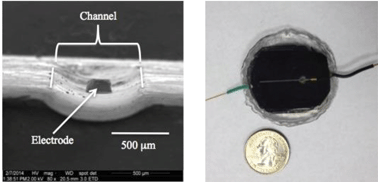Fabrication and characterization of all-polystyrene microfluidic devices with integrated electrodes and tubing
Abstract
A new method of fabricating all-polystyrene devices with integrated electrodes and fluidic tubing is described. As opposed to expensive polystyrene (PS) fabrication techniques that use hot embossing and bonding with a heated lab press, this approach involves solvent-based etching of channels and lamination-based bonding of a PS cover, all of which do not need to occur in a cleanroom. PS has been studied as an alternative microchip substrate to PDMS, as it is more hydrophilic, biologically compatible in terms of cell adhesion, and less prone to absorption of hydrophobic molecules. The etching/lamination-based method described here results in a variety of all-PS devices, with or without electrodes and tubing. To characterize the devices, micrographs of etched channels (straight and intersected channels) were taken using confocal and scanning electron microscopy. Microchip-based electrophoresis with repetitive injections of fluorescein was conducted using a three-sided PS (etched pinched, twin-tee channel) and one-sided PDMS device. Microchip-based flow injection analysis, with dopamine and NO as analytes, was used to characterize the performance of all-PS devices with embedded tubing and electrodes. Limits of detection for dopamine and NO were 130 nM and 1.8 μM, respectively. Cell immobilization studies were also conducted to assess all-PS devices for cellular analysis. This paper demonstrates that these easy to fabricate devices can be attractive alternative to other PS fabrication methods for a wide variety of analytical and cell culture applications.

- This article is part of the themed collection: Microfluidics Research 2015-2016

 Please wait while we load your content...
Please wait while we load your content...